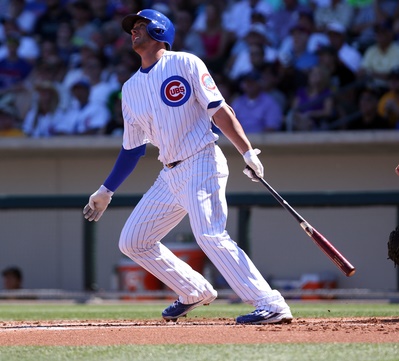In 2014, the Cubs struck out more often than any other team in MLB—24.2 percent of the time. That was true despite their walking only 7.2 percent of the time, below the league average of 7.5 percent, which was a record-low league figure for modern baseball, anyway. Offense can’t survive in the environment the Cubs created for it last year. A team has to put together better at-bats than that.
In 2015, the Cubs started horrendously in this regard. They scored only two runs in their two games against the Cardinals, striking out 23 times and drawing only three walks in 62 plate appearances. If offense suffocates in the air mixture created by last year’s strikeout and walk rates, it’s actively strangled by rates like those. The Cardinals absolutely choked out the Chicago offense.
That was never going to last, though. That’s not the identity of this team anymore. Over the winter, the front office got about five times as serious about their commitment to seeing players get on base as they had ever been before. It used to be a company line, a thing to which they gave consistent but non-binding lip service. This past offseason, it finally became a philosophy in action.
The 2014 Cubs had above-average aggregate OBP figures at three positions: first base, left field and shortstop. The team returned all three of the regulars who posted those numbers, as they were almost certain to do. Whether you believe in Chris Coghlan or not—I do, and you should, but even if you don’t—the trio of Anthony Rizzo, Starlin Castro and Coghlan was a fine starter kit for a real big-league offense. They left a lot of work to do, though, and for the first time, the late season and offseason provided some answers.
Last year, the Cubs’ aggregate OBP from the catcher’s spot was .285. At second base, it was .280. In center field, it was a putrid .264. Without changing those numbers, the team was not going to be able to score at even an average level, with or without the likes of Kris Bryant and Jorge Soler.
Miguel Montero’s PECOTA-projected OBP for 2015 was .332. Tommy La Stella’s was .341. Dexter Fowler’s was .343. If you wanted to, you could build really strong narratives supporting the notion that each player would outperform those. Even without them doing so, though—even if they only met, or nearly met, those numbers—the Cubs were going to realize huge offensive gains there. The difference between the trio’s aggregate projected OBP and the 2014 team levels is worth some 90 extra times on base, in around 1,500 plate appearances. Ninety fewer outs made in the same number of plate appearances. That’s worth 30 runs, without breaking a sweat. The Cubs went a bit out of their way to add each player. La Stella’s arrival complicated an already complicated middle-infield muddle; Montero cost a fine pitching prospect and will now cost $40 million over three years; and a year of Fowler cost two years of Luis Valbuena, plus a morsel of the Cubs’ starting pitching depth, in Dan Straily. The juice should be well worth the squeeze.
I’m 500 words deep in a piece about Kris Bryant joining the Cubs’ offense, and have mentioned Bryant only in passing. Sorry about that. But it’s not an accident! The moral of the story, here, is that Bryant isn’t going to be asked to save this offense. If that’s why you’ve been eagerly awaiting his arrival, you’re doing it wrong. Rather, Bryant is the final piece, the guy who makes an offense that already looks good a lot better. He lengthens a lineup already full of players who take good at-bats and are dangerous if a pitcher makes a mistake. He’s also only the tip of this spear, with Javier Baez and Addison Russell threatening to make the Cubs the deepest offense in the league by the trade deadline. In the meantime, though, consider: the Cubs have 42 strikeouts, 27 walks, nine home runs and 30 runs scored over their last six games. There was only one stretch in all of 2014 during which the Cubs had 27 or more walks in six games. There were only two during which they struck out 42 or fewer times. There was no overlap between those stretches.
I picked the Cubs to win the NL Central, which might have seemed a symptom of succumbing to spring hype. It was quite the opposite, though, because there existed hardly any relationship between the things that make the Cubs dangerous and the things that made them popular during spring training. They’re not good because they have the best farm system or most right-handed power in baseball, but because they have so many elements around those things that had been missing from previous iterations of the club, and that are missing from many teams throughout the league.
With Bryant sliding into the lineup just in time to pick up the slack of the banged-up infield, and with reinforcements on the way, Chicago could have—this is not hyperbole—the best offense in the National League. They have balance, they have depth, and they have, for the first time in years (their last above-average team walk rate came in 2009), an approach. Bryant isn’t the cornerstone of this offense; he’s the capstone.

Great article.
This made me very happy. Thank you.